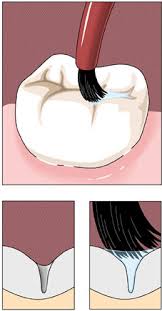Pit and Fissure sealants
The sealing of fissures and pits is the
preventive/therapeutic closing of the chewing surface (that is particularly
vulnerable to caries) with a highly fluid synthetic compound.
Patients with a high risk for
caries, as well in patients with healthy
teeth with fissures vulnerable to caries, should have a sealing of the fissures
and pits done early.
What are pits
and fissures?
The top surfaces of your teeth - where the
chewing takes place - aren't smooth and flat. They are cris-crossed with tiny
hills and valleys - called pits and fissures. These are places where plaque can
build up safe from your toothbrush and dental floss. Some of the pits and
fissures are so narrow that even a single bristle from your toothbrush can't
get deep enough to clean them out.
The objective is to transform the chewing surface of the tooth by applying the sealant into a plaque retentive
relief and thus into a surface suitable for prophylaxis.
.
One method of preventing cavities from developing in the pits and fissures is to seal them off with a special varnish called a pit and fissure sealant. If your dentist determines that you need a pit and fissure sealant to help protect your teeth from decay, some special steps are taken to prepare the teeth first.
1. Your dentist will clean the tooth first with small rotating brushes or an abrasive particle polishing paste.
2.Afterwards, the surface of
the unprepared dental enamel surface is conditioned with approx. 35% phosphoric
acid gel for about 60 seconds on a permanent tooth and for about 120 seconds on
a milk tooth.
3. After the thorough
spraying and washing of the etching gel
for at least 10 seconds and a forced drying, a chalk-like white enamel surface
must be visible which will make it easier for the pit and fissure sealant to
stick.
5. A special kind of light
cures the sealant and makes it ready for use.
Contraindications to fissure and pit sealing are broad dentin lesions, incompletely erupted teeth, and milk molars, whose second dentition is imminent.

No comments:
Post a Comment